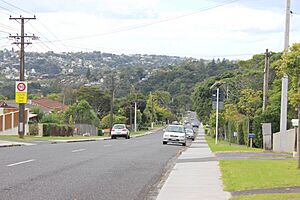Birkdale, New Zealand facts for kids
Quick facts for kids
Birkdale
|
|
|---|---|
|
Suburb
|
|

Looking north from Salisbury Road, Birkdale
|
|
| Country | New Zealand |
| Local authority | Auckland |
| Electoral ward | North Shore Ward |
| Local board | Kaipātiki Local Board |
| Area | |
| • Land | 290 ha (720 acre) |
| Population
(June 2023)
|
|
| • Total | 9,460 |
| Postcode(s) |
4159
|
|
|
||
Birkdale is a suburb located in Auckland, New Zealand. It's part of the large Auckland city area. This area was first called Parkview. In 1889, it was renamed Birkdale. The new name came from a suburb in Birkenhead in England.
Today, Birkdale is part of the North Shore. It is managed by the Auckland Council.
Contents
Who Lives in Birkdale?
Birkdale covers an area of about 2.9 square kilometers. As of 2023, around 9460 people live here. This means there are many people living close together.
| Historical population | ||
|---|---|---|
| Year | Pop. | ±% p.a. |
| 2006 | 7,896 | — |
| 2013 | 8,337 | +0.78% |
| 2018 | 8,898 | +1.31% |
In 2018, Birkdale had a population of 8,898 people. This was an increase from previous years. There were 2,856 homes in the area. About 1,932 people (21.7%) were under 15 years old.
Birkdale is a diverse place. Many different groups of people live here. In 2018, about 65.2% of residents were European or Pākehā. Around 13.1% were Māori. About 9.7% were Pacific peoples. Also, 22.2% were Asian. About 5.0% belonged to other ethnic groups.
Many people living in Birkdale were born overseas. This makes the community very interesting. When asked about religion, many people said they had no religion (49.4%). Others were Christian (36.9%). Smaller groups followed Hinduism, Islam, or Buddhism.
Schools in Birkdale
Birkdale has several schools for different age groups.
Birkenhead College: Secondary School
Birkenhead College is a secondary school. It teaches students from Year 9 to Year 13. The school opened in 1972. It was first called Birkdale College. The name changed in 1988. Many successful people have gone to this college. These include athletes, artists, and scientists. For example, famous football players Duncan Cole and Bill Tuiloma studied here. Singer Kim Willoughby and comedian Melanie Bracewell are also alumni. In 2020, Metro magazine named Birkenhead College a top-10 school for Art. The school celebrated its 50th birthday in 2023.
Birkdale Intermediate: Middle School
Birkdale Intermediate is for students in Years 7 and 8. It helps students get ready for secondary school. Many primary schools in the area feed into Birkdale Intermediate. These include Beach Haven, Birkdale, Birkdale North, Kauri Park, and Verran.
Birkdale Primary Schools
There are two main primary schools in Birkdale. They are Birkdale North School and Birkdale Primary School. These schools teach students from Year 1 to Year 6.
Birkdale Primary School's History
Birkdale Primary School opened in 1894. Before that, parents asked for a school for their children. The school was built with one classroom. It cost 109 pounds. Miss Rosanna Brown was the first teacher. She taught 32 students. As more children joined, another room was added in 1895.
The school's badge has a strawberry leaf on it. This shows that students used to pick strawberries for local farms. Today, Birkdale Primary has both English and Māori language classes. The Māori language unit, Te Puāwaitanga, started in 1986. It was the first of its kind on the North Shore.
Durham Hall is the oldest building at the school. It was built in 1940 as a classroom. It is named after Glady Durham. She was a former student and helped the school for many years. This hall is now protected as a historical building.
Kauri Park School was originally called Birkdale West School. Verran Primary was first planned as Birkdale East School. All these schools are coeducational, meaning both boys and girls attend.


